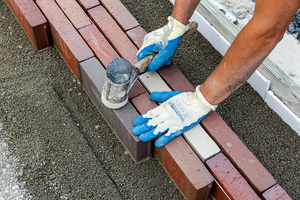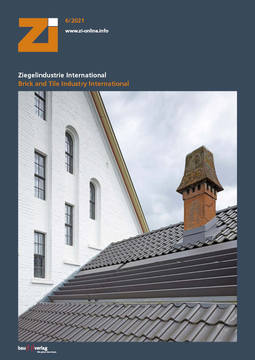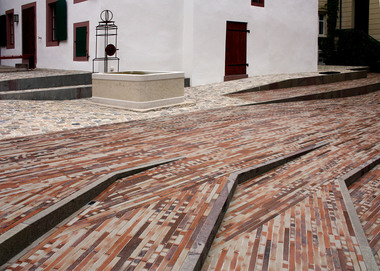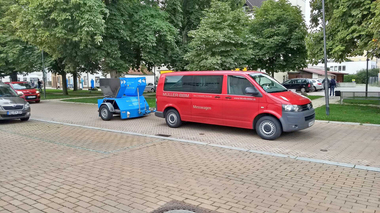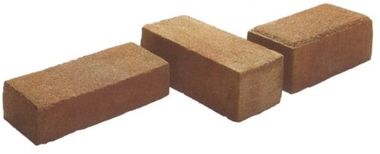Bonded laying for special building projects
Laying pavers in a mortar bed with a fixed joint offers planners and architects very special design and application possibilities. However, the bonded construction of pavers makes special demands on planning, choice of building material, construction and construction control.
The bonded construction method is mainly used where high resistance to deformation is required and special demands are made on the stability of the joint.
In bonded construction, the pavers, bedding mortar and grout form a permanent, rigid bond. The load-bearing behaviour corresponds to a rigid slab. This results in special features that must be taken into account when planning the structural design of the paved surface, the choice of building material, field sizes and movement joints, as well as construction and construction control.
Special requirements for the bonded construction method
For private landscaping areas that are not assigned to public road construction, the requirements of the ZTV für den Bau von Wegen und Plätzen (ZTV Wegebau) should be observed. The requirements for surfaces are differentiated according to their use, depending on whether they are exclusively walked on, driven on by motor vehicles or, in exceptional cases, are also used by regular or delivery traffic. These requirements include, among others, the installation of movement joints, a drainage plan for the drainage of surface water, and the appropriate dimensioning of the superstructure depending on the category of use.
The base layer of the paved surface can be bound or unbound. For road traffic and use category N3, a bound base layer is required. Jointing mortar is available in water-impermeable (cement mortar) or water-permeable (mortar made of synthetic resin) versions. Bedding mortar, on the other hand, must be water-permeable, because even when cement mortar is used, moisture can penetrate the substrate through hairline cracks. It is recommended to seek advice from the manufacturer of the mortar systems.
Bonded clinker pavers are made from the base. In this process, the pavers are provided with an adhesive primer and manually set into the bedding mortar at the correct height and hammer tight with a joint width of 8 ± 3 mm. Once set, they must not be readjusted or vibrated. The thickness of the bound bedding should be 4 to 6 cm and the bedding mortar should not rise more than one third of the joint height. The permissible outdoor temperatures and the working time for the bedding mortar must be observed. The pavement should be protected from the weather and dirt until the final grouting is completed.
The time of jointing depends on the materials used, the weather conditions and the strength of the bedding mortar. Once the bedding mortar has dried sufficiently, the remaining joint space is completely filled with grout.
The surface should be kept constantly damp with a spray mist and mortar residues should be removed immediately to avoid mortar residues sticking to the clinker and the associated cement haze. For larger surfaces, the use of a sponge plastering machine is recommended, which directly picks up mortar residues and prevents them from spreading further over the surface. If a slight cement haze has nevertheless formed, it can be removed by manual cleaning or special chemical cement haze removers, or will be rubbed off over time through use.
Bonded paving slabs for traffic areas
The FGSV working paper “Surface pavements with paved and slabbed surfaces in bonded design” provides information and recommendations on bonded paved surfaces for traffic areas that can be assigned to the load classes of RStO 12. The information sheet E 5 21 07/D “Bonded construction - historic paving” of the Wissenschaftlich-Technische Arbeitsgemeinschaft Bauwerkserhaltung und Denkmalpflege e.V. (WTA) also provides information and recommendations. (WTA) also contains information and recommendations on the bonded construction method.
Since the bonded construction method is not considered a standard design, it is necessary to develop separate service texts for the tendering and construction contract processing of a construction project with bonded paving. These must contain complete information on the building materials to be used, the construction work and quality assurance.
Free technical brochure of the Pavers Working Group
Interested parties can obtain further information on the planning, design and construction of surfaces with original paving clinkers in the free brochure “Technical Information on Paving Clinkers” published by the Working Group for Paving Clinkers (Arbeitsgemeinschaft Pflasterklinker e.V.). The almost 100-page practical work is a valuable aid for planners and builders of paving clinker surfaces and is based on the current status of technical regulations, the latest scientific findings and decades of practical construction experience. The technical brochure can be ordered or downloaded from www.pflasterklinker.de.


